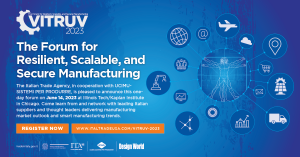Though not the flashiest Italian car manufacturer, automotive firm Fiat has long been a staple of the country's industrial sector, providing vehicles to a wider mass market than its local brethren: —the Ferraris, Maseratis and Lamborghinis that cater only to the elite.
As such, the firm's research and development center, with a main base in Orbassano, Turin, is constantly thinking up ways to reinvent its automotive products in cost effective ways, from their physical design to their fuel efficiency, safety features and beyond.
Established in 1978 as the Fiat Group reference center for innovation, the Centro Ricerche Fiat (CRF) is responsible for almost all of the company's technological growth. Its 1,000-strong staff (600 of whom are engineers) is permanently engaged in looking to substitute car components and materials, while maximizing sustainability, safe mobility, telematics, mechatronics and even optics.
"Italy loves cars and of course many young engineers love working on cars," said general manager of the CRF, Stefano Re Fiorentin. Besides its main site in Orbassano, the CRF boasts three decentralized branches in Bari, Trento and Foggia, with one more site dealing exclusively with the advanced research of optics and plastics for lighting systems at Udine.
{pagebreak}
Over 1,000 industrial partners, including universities and various research centers across the world, serve to swell the CRF's ranks and propel it even further forward. The center also absorbs engineers from scholarship programs it has in association with Turin Polytechnic and Windsor University in Canada.
Currently holding a total of 2,860 patents (both granted and pending), the CRF can take direct credit for a number of important innovations in Fiat cars, mainly in terms of powertrains, the Diesel Common Rail System (Unijet and multijet) and the new TwinAir engine.
The center's engineers spend much of their time designing Fiat's future powertrains, chassis and bodies, as well as the related electronics needed in-car. Integration of electronics with mechanics is a key part of the work, said Re Fiorentin, with "integrated approaches" being the center's buzz word, and meaning the combination of various disciplines to get the best performance. In terms of hi-tech in-car connectivity, the center is also responsible for Fiat's set of Blue&Me connectivity products, driving advisor and magic parking driver assistance systems, as well as the Eco drive navigation product suite.
Undoubtedly, however, the CRF remains mainly focused on problems of propulsion, as petrol supplies dwindle globally.
{pagebreak}
Natural gas as an interim fix
Today, almost every car manufacturer has had to "pick a side" when it comes to alternative fuel options, looking for ways to divest from a reliance on regular gas. Mercedes, for instance, has put its money on diesel, while Toyota has taken the hybrid approach and BMW is banking on hydrogen fuel cells. Fiat, meanwhile, is looking to back compressed natural gas (CNG) or liquid propane as its interim solution of choice. Cheap and readily available, liquid propane is the same stuff used to power most gas barbeques, and has natural reserves predicted to last for well over 100 years. It provides 23 percent fewer Co2 emissions compared with gasoline, offers the same performance and is economically sustainable.
Fiat is looking for ways to maximize the storage of liquid propane onboard its vehicles, with the CRF re-examining tank technology, to see whether a dual fuel option, including both regular and natural gas, is feasible and cost efficient. As it turns out, such a system would require very little retro fitting, with very few modifications to the engine needed. As such, it would be cheap, with almost no development costs involved. On the other hand, despite the savings of not having to re-engineer its engines, Fiat would, in a way, be taking a step back, using old technology for a new fuel approach. There is also a distinct lack of filling stations for natural gas, and low incentive for gas rich markets like the U.S. to use it.
Despite the various pros and cons, one thing remains clear; Fiat does not want to be left behind. "We are providing an evolution of the features of the car and better performance," said Re Fiorentin, noting the importance of decarbonizing the emissions from cars, improving their safety and ensuring their affordability.
The center is also actively working with fuel and infrastructure providers and looking for other interim solutions, with a view to electric cars as an end goal. At the moment, however, Re Fiorentin doesn't see the electric car as a short term eventuality.
"The electric car still has some sustainability problems, not from the environmental point of view but from the social and economic point of view, because the ranges are too limited, recharging times are too long, and cost too high," he said.
"The challenge is to remain competitive in a market that has become more and more aggressive. We need very skilled people. People who knowing a discipline and know how that discipline integrates with others."


























